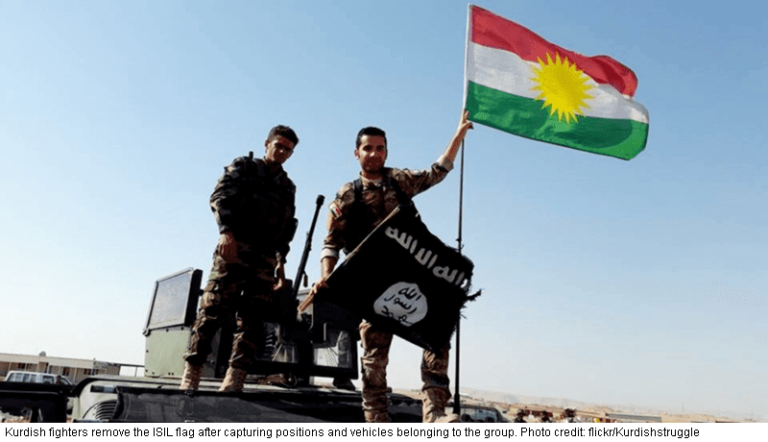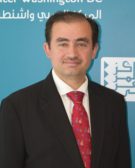
While the battle against the so-called Islamic State (IS) in Syria approaches its end, complications abound at the political level due to the mostly antagonistic involvement of numerous groups on the Syrian battlefield. Forces of the Kurdish People’s Protection Units (YPG) have laid siege to IS’s capital, Raqqa, with help from the US-led international coalition’s air power. On the other side, the Syrian Army, assisted by Russian air assets, has succeeded in crossing the Euphrates River and laying siege to the city of Deir Ezzor, which IS calls the “Wilayah of Plenty” because of its mineral and agricultural riches that have benefited the millennial organization for years.
A number of questions arise as this battle comes to a much-hoped-for close and as many parties debate the future of Syria. These questions address the possibility of arriving at a political solution for the almost seven-year conflict, the fate of Syrian President Bashar al-Assad, the positions of the different parties—domestic and foreign—to the conflict, and the outcome of developments in the Idlib Governorate, to name a few. But whatever the answers may be, it would be wise to look at Syria’s developments today with a healthy dose of skepticism because the Syrian war has shown that nothing is final, certain, or universally accepted by all concerned.
Whither the “Political Solution”?
On September 18, a Ministerial Friends of Syria conclave was held on the sidelines of the United Nations General Assembly’s annual meeting in New York. What was salient was the declaration by British Foreign Secretary Boris Johnson that “the only way forward” for Great Britain and the western powers “is to get a political process going and to make it clear to the Iranians, Russians and Assad regime that we, the like-minded group, will not support the reconstruction of Syria until there is such a political process and that means, as Resolution 2254 says, to a transition away from Assad.”
This British position about rejecting Assad, buttressed by others, seems to be firm. But what also is understood is that the western position on Syria has wavered regarding the demand for Assad’s departure, and it lacked any effect on the ground during the initial political transition in the country or on a resolution of the Syrian dilemma. What indeed has stymied the West is the opposite position, led by Russia, which has insisted on rehabilitating Assad and strengthening him militarily and politically by helping him gradually regain lost territory. This has also been accompanied by establishing the “de-escalation zones” that have opened the door to local reconciliation, allowing the regime to once again offer its services as the opposition continues to be unable to provide for basic needs like water and electricity.
This track has also been accompanied by a Russian drive, under the auspices of the United Nations, to neglect the Geneva process and strengthen the Astana alternative, one that seeks to establish the de-escalation zones. However, the seven Geneva meetings have led nowhere on the political and humanitarian fronts. At the same time, the Syrian regime has rejected discussing—and subsequently implementing—what was hoped for regarding five different issues: forming a non-sectarian government in six months; writing a constitution; holding internationally supervised elections within 18 months; building mutual confidence; and fighting terrorism.
In fact, each of the Geneva meetings ended in failure and with antagonism among the participants. This, in turn, led to half-measure solutions that showed the regime’s lack of commitment and sincerity to advance a political solution and the opposition’s inability to influence the outcome. Instead, Russia worked to pressure the regime to accept the Astana process, whose meetings have become regularized and more serious. What was interesting in this regard is the declaration by Turkish President Recep Tayyip Erdoğan before the last meeting that the Astana negotiations are in their final stages; this indicates that Turkey has added its weight to the process and has abandoned whatever pretense it held in supporting the Geneva approach.
Astana and the Idlib Battle
The last Astana round of talks was hastily arranged and it was evident that, like the two previous meetings, the regime and the opposition were treated simply as almost decorative additions. Meeting outcomes and the final communiqué appeared to have been agreed to beforehand between the so-called “guarantor states”—Russia, Iran, and Turkey. After the last meeting, a fourth area—Idlib—was added as a de-escalation zone; this time, the opposition could not object to the decision because of the Turkish position on the matter. In fact, President Erdoğan had prevented the opposition from even voicing its opinion or submitting its demands, despite forcing it to attend. The opposition’s demands had always included provisions for the release of political prisoners and the lifting of the regime’s siege on areas close to Damascus. In other words, Turkey was insisting on the success of the Astana round because it gave Ankara a green light to undertake the mission of ridding Idlib of Hay’at Tahrir al-Sham, previously the Nusra Front.
And that indeed is what transpired. As soon as the Astana talks were concluded, Turkish forces were deployed close to the Syrian border in preparation for a military operation intended to rid the area of Hay’at Tahrir al-Sham, in the process preventing the United States and its Kurdish ally, the YPG, from attacking the region and occupying it. Turkey also wanted to disallow regime forces from attacking the area after they succeeded in laying siege to Deir Ezzor. Taking over Idlib and getting rid of “extremist groups” had also been the objective of the Syrian regime and Russia; this would simultaneously lead to controlling the border crossings between Syria and Turkey.
Over the last few months, Turkey has found itself in a difficult position, which was an outcome of its hesitation and trepidation during the last four years to seize opportunities to change facts on the ground in its favor. The YPG, which Turkey considers a terrorist organization, has now become the United States’ main strategic ally in Syria in its war against the Islamic State. Washington even rejected all Turkish entreaties to stop arming the Kurds and demands to participate directly in fighting IS in Syria. Instead, the United States, under both Obama and Trump, preferred to cooperate with and support the Kurds, a situation that created tension and estrangement between the two erstwhile NATO allies.
Thus, Turkey realized that any hesitation at this time could lead to further erosion of its position and prestige vis-à-vis the Syrian war on its southern border. This is why it massed its armor and troops on the border of Idlib to launch a military operation inside Syria, as it did previously in the battle for the city of al-Bab. An invasion of Idlib could also provide Turkey with the opportunity to put the area under the control of the Free Syrian Army, which can then mollify American and Russian demands to eradicate the danger represented by al-Qaeda’s friends in the region.
Turkey knows that its battle against Hay’at Tahrir al-Sham is not likely to be an easy one and might require extensive military and logistical needs. Without help from American or Russian air assets for the battle, Turkey may have to prepare for compromises that could convince the United States to consider offering military assistance.
Daesh’s Final Exit from Deir Ezzor
What was evident over the last month was the advance of the Syrian regime toward the Euphrates Valley to complete its encirclement of Deir Ezzor and force the Islamic State to abandon the city. This development was strange because it signaled a change in conduct of the regime’s operations since, over the last several years of the war, the Syrian Army has concentrated on fighting the opposition in areas far away from IS positions. The regime even committed numerous crimes against civilians while pursuing the Free Syrian Army in areas that had circumvented government control since the early days of the conflict. Government forces even laid siege to entire cities and prevented water, food, and medical deliveries; they also bombarded these areas with thousands of barrel bombs that killed thousands of people over the length of the conflict. In 2016 alone, almost 13,000 such bombs were used against targets around the country, killing at least 653 civilians according to a report by the Syrian Network for Human Rights. The regime was indifferent about IS’s expansion and actually was the main source of income for the organization by buying oil from oilfields under its control. Even Russia justified its intervention by emphasizing the mission of fighting the Islamic State.
Suddenly, regime forces, which had been exhausted over years of conflict, found the necessary energy and drive to cross the Euphrates to break the siege on their colleagues at Deir Ezzor’s regime-controlled air base. That obviously happened with great Russian aerial assistance. But, importantly, it was done as the regime understood the dangers posed by the expanding Kurdish presence in the northeastern part of the country, since the Kurds have now become competitors in the battle for control of the region.
There are differences in how Russia and the United States see the situation in Deir Ezzor and their role in the battle. While Russia looks at the area as part and parcel of what has become known to Moscow as a “useful Syria,” the United States has shown what can derisively be seen as nonchalance, for the primary American aim is the defeat of the Islamic State. As the Trump Administration considers its involvement in Syria, it is stalled by developments in Washington itself, where investigations into the Russia affair are ratcheting up in a manner that forces the administration to lessen its interest in overseas affairs and concentrate on how to escape its existential threat. Further, the Trump team sees no utility in expending political or financial treasure to assure a political transition in Syria.
As for Russia, it perceives Syria’s developments from a utilitarian point of view—of benefit and efficacy. In this case, Russia sees its military intervention in Syria in terms of increasing its ability to exploit whatever resources it finds in Deir Ezzor or elsewhere. President Vladimir Putin knows that Syria is poor and that its authoritarian regime does not encourage economic development; in addition, it has no infrastructure that could benefit foreign investment capital, including Russia’s. Russia also does not have the economic means to help in Syria’s reconstruction. All these factors lead to the conclusion that perhaps all that Russia can do for now is exploit what it can of Deir Ezzor’s natural resources; it will wait for foreign and western sources to start the process of rehabilitating Syria.
Where to, Syria?
These increased complications in the Syrian scene push all the actors to recalculate their positions. The Islamic State’s inheritance today is merely territory that is essential for all parties’ agendas in Syria. This territory has shrunk in Syria and Iraq by 60 percent since its largest expansion in 2015. The organization is under siege in its capital, Raqqa, and is under attack from the YPG, the Syrian Army, Russia, and the US-led coalition. It appears that the only party that is also losing on the battlefield is the Syrian opposition, which has not been able to carve out an enclave for itself or to be independent enough to influence events on the ground.
But what is certain is that despite the Islamic State’s imminent demise and the apparent successes and failures of the different actors, all changes are in fact fleeting and cannot be confirmed. It is important to understand that so long as a political solution for the Syrian crisis remains remote and the true aspirations of the Syrian people in a democratic system are not realized, any political solution is unlikely to endure.

